战略地图概述
- 格式:pptx
- 大小:220.74 KB
- 文档页数:5
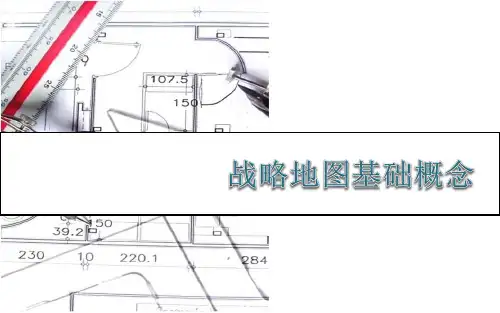
OM-USB-1208FS, OM-USB-1408FSU L ow Cost, MultifunctionUSB Devices with 4 Differential or 8 Single-Ended Analog Inputs U P rovides 12-Bit (OM-USB-1208FS) or 14-Bit (OM-USB-1408FS) Analog Input Resolution U M aximum Sampling Rates Ranging from 1.2 kS/s to 50 kS/s U 2 Analog Outputs U 16 Digital I/O Lines U O ne 32-Bit Counter Input Channel U N o External Power RequiredThe OM-USB-1208FS and OM-USB-1408FS dataacquisition modules offer four differential (DIFF) or eight single-ended (SE) analog inputs, two analog outputs, 16 digital I/O channels, and one counter input.These modules are USB 2.0 full speed voltage input data acquisition modules (fully compatible with both USB 1.1 and USB 2.0 ports). These are plug-and-play modules which draw power from the USB cable - no external power supply is required. All configurable options (including individual channel ranges) are software programmable, and the modules are fully software calibrated.Both modules feature eight analog voltage input channels that are processed through a single A/D converter. The analog inputs to the OM-USB-1208FS are software configurable for either eight 11-bit single-ended or four 12-bit differential inputs. The analog inputs to the OM-USB-1408FS are software configurable for either eight 13-bit single-ended or four 14-bit differential inputs.These modules have one 32-bit counter channel. The digital I/O channels are software programmable for input or output. Both models have two 12-bit analog outputs. The packaging for the OM-USB-1208FS and OM-USB-1408FS ensures ease of use in a variety of applications.OM-USB-1208FS shown actual size.The OM-USB-1208FS and OM-USB-1408FS data acquisition modules are supplied with TracerDAQsoftware which is a collection of four virtual instrument applications used to graphically display and store input data and generate output signals:• S trip Chart—Log and graph values acquire from analog inputs, digital inputs, temperature inputs and counter inputs• O scilloscope—Display values acquired fromanalog inputs• F unction Generator—Generate waveforms for analog outputs•R ate Generator—Generate waveforms for counter outputsT racerDAQ PRO is an enhanced version of TracerDAQ. A comparison of some of the features included in TracerDAQ vs TracerDAQ PRO is shown on the next page.TracerDAQ Pro Strip Chartwith Measurements.TracerDAQ Strip Chart.digital input, event counter digital input, event counter Time-of-Day Triggering No YesMath Channel No YesFeatures ComparisonSOFTWAREOM-USB-1208FS and OM-USB-1408FS modules ship with an impressive array of software, including the new TracerDAQ®, a full-featured, out-of-the-box data logging, viewing, and analysis application. Driver support and detailed example programs are included for Universal Library programming libraries for Microsoft® Visual Studio® programming languages, and other languages, including DASYLab®, and ULx for NI LabVIEW®(comprehensive library of Vls and example programs compatible with 32-bit and 64-bit LabVIEW v8.5 through 2013) and InstaCal™ installation, calibration andtest utility - powerful solutions for programmers and nonprogrammers alike. These modules operate under Microsoft Windows® XP (32-bit only) and VIST A/7/8 (32-bit and 64-bit) operating systems.ANALOG INPUTOM-USB 1208FS: These devices provide eight, 11-bit single-ended analog inputs or four, 12-bit differential analog inputs.OM-USB 1408FS: These devices provide eight, 13-bit single-ended analog inputs or four, 14-bit differential analog inputs.All devices support software selectable ranges that provide inputs from ±1V to ±20V in a differential configuration, and ±10V in a single-ended configuration.OM-USB-1408FS8 SE/4 DIFF48 kS/s max2±6.0 mA per Pin1GENERAL INFORMATIONSAMPLING RATE: When scanning continuously to computer memory (hardware-paced mode), theOM-USB-1208FS can sample at a maximum of50 kS/s, and the OM-USB-1408FS can sample ata maximum of 48 kS/s.CHANNEL-GAIN QUEUEThe channel-gain queue feature lets you configure a list of channels and gains for each scan. Each channel can have a different gain setting. The gain settings are stored in a channel-gain queue list that is written to local memory on the device.The OM-USB-1208FS and OM-USB-1408FS channel-gain queue can contain up to 16 channels listed in any order.ANALOG OUTPUTThe maximum analog output update rate for all devices depends on several factors, including USB port speed. Both devices offer two 12-bit analog outputs with a range of 0V to 4.096V.When updating continuously from computer memory (hardware-paced mode), one analog output updates at a maximum rate of 10 kS/s; two analog outputs update simultaneously at a maximum rate of 5 kS/s each. DIGITAL I/OAll devices provide 16 TTL-level digital I/O lines. Digital I/O can be programmed on each 8-bit port (Port A and Port B) for either input (default) or output.EVENT COUNTER INPUTEach device supports one 32-bit TTL-level counter that accepts inputs up to 1 MHz.SPECIFICATIONSANALOG INPUTA/D Converter Type: Successive approximation Channels: 8 single-ended (SE) or 4 differential (DIFF), software programmableInput Common-Mode Voltage Range for Linear Operation:SE Mode: CHx to GND, ±10V maxDIFF Mode: CHx to GND, -10V min, 20V max Absolute Maximum Input Voltage: CHx to GND,±28V maxInput Impedance: 122 kΩRanges: Software selectable on a per-channel basis SE Mode: ±10VD IFF Mode: ±20V, ±10V, ±5V, ±4V, ±2.5V, ±2.0V,±1.25V, ±1.0VThroughput: Maximum throughput scanning to computer memory depends on the computer being used. Software Paced: 250 S/s typ, system-dependentHardware Paced:OM-USB-1208FS: 50 kS/sOM-USB-1408FS: 48 kS/sChannel Gain Queue: Up to 16 elements, software-selectable channel and rangeResolution:OM-USB-1208FS:DIFF: 12 bits, no missing codesSE: 11 bitsOM-USB-1408FS:DIFF: 14 bits, no missing codesSE: 13 bitsCAL Accuracy (OM-USB-1208FS Only):CAL = 2.5 V, ±36.25 mV maxIntegral Linearity ErrorOM-USB-1208FS: ±1 least significant bit (LSB) typ OM-USB-1408FS: ±2 LSB typDifferential Linearity Error: ±0.5 LSB typ Repeatability: ±1 LSB typCAL Current (OM-USB-1208FS Only):Source: 5 mA maxSink: 20 μA min, 100 μA typ2.5VREF Accuracy (OM-USB 1408FS Only):±36.25 mV max2.5VREF Output Current (OM-USB 1408FS Only): Source: 5 mA maxSink: 20 μA min, 100 μA typTrigger Source (Software-Selectable):External Digital: TRIG_INClock Source: Internal; External (SYNC), rising edgetriggeredANALOG OUTPUTNumber of Channels: 2Output Range: 0V to 4.096V, 1 mV per LSB Resolution: 12 bits, 1 in 4096Throughput: Maximum throughput scanning to computer memory depends on the computer being used S oftware Paced: 250 S/s single channel typ, system-dependentHardware Paced:Single Channel: 10 kS/sDual Channel: 5 kS/s Power On and Reset VoltageOM-USB-1208FS: Initializes to 000h codeO M-USB-1408FS: 0V, ±20 mV typ, initializes to 000h codeOutput Drive (Each D/A OUT): 15 mASlew Rate: 0.8V/μs typAccuracy (All Values are ±): 0V to 4.096V: 4.0 LSB typ, 45.0 LSB maxAnalog Output Accuracy Components(All Values are ±): 0V to 4.096V% of FSR: 0.1 typ, 0.9 maxGain Error at Full Scale: 4.0 mV typ, 36.0 mV max Offset: 1.0 mV typ, 9.0 mV max% of at Full Offset Scale ±2V0.2 4 9.766 13.766Least Significant Bit- Least Significant Bit-DIGITAL I/O Digital Type: CMOSNumber of I/O: 16 (Port A0 through A7, Port B0 through B7)Configuration: 2 banks of 8Pull Up/Pull-Down Configuration: All pins pulled up to 5V through 47 kΩ resistors (default); change to pull-down using internal user-configurable jumpers.Input High Voltage: 2.0V min, 5.5V absolute max Input Low Voltage: 0.8V max, -0.5V absolute min,0V recommended minOutput High Voltage (IOH = -6.0 mA): 3.84V min Output Low Voltage (IOL = 6.0 mA): 0.33V max Power On and Reset State: InputEXTERNAL TRIGGERTrigger Source: External digital, TRIG_INTrigger Mode: Edge sensitive; software-selectable for CMOS-compatible rising or falling edgeTrigger Latency: 10 μs maxTrigger Pulse Width: 1 μs minInput Type: Schmitt trigger, 47 kΩ pull-down to ground Schmitt Trigger Hysteresis: 1.01V typ, 0.6V min, 1.5V maxInput High Voltage Threshold: 2.43V typ, 1.9V min, 3.1V maxInput High Voltage Limit: 5.5V absolute maxInput Low Voltage Threshold: 1.42V typ, 1.0V min, 2.0V maxInput Low Voltage Limit: -0.5V absolute min, 0V recommended min EXTERNAL CLOCK INPUT/OUTPUTPin Name: SYNCPin Type: BidirectionalDirection (Software-Selectable):I nput (Default): Receives A/D clock from external source; active on rising edgeO utput: Outputs internal A/D clock; active on rising edgeInput Clock Rate:OM-USB-1208FS: 50 kHz, maxOM-USB-1408FS: 48 kHz, maxClock Pulse Width:Input Mode: 1 μs minOutput Mode: 5 μs minInput Type: Schmitt trigger, 47 kΩ pull-down to ground Schmitt Trigger Hysteresis: 1.01V typ, 0.6V min, 1.5V maxInput High Voltage Threshold: 2.43V typ, 1.9V min, 3.1V maxInput High Voltage Limit: 5.5V absolute maxInput Low Voltage Threshold: 1.42V typ, 1.0V min, 2.0V maxInput Low Voltage Limit: -0.5V absolute min,0V recommended minOutput High Voltage: 4.4V min (IOH = –50 μA),3.80V min (IOH = –8 mA)Output Low Voltage: 0.1V max (IOL = 50 μA),OM-USB-1408FSshown actual size.Ordering Example: OM-USB-1208FS 12-bit voltage input USB data acquisition module (4 DE/8 SE analog input channels, 16 digital I/O, 1 counter, 2 analog outputs) and OCW-1, OMEGACARE SM extends standard 1-year warranty to a total of 2 years.Input Type: Schmitt trigger, 47 k Ω pull-down to ground Input Source: CTR screw terminal Resolution: 32 bitsMaximum Input Frequency: 1 MHz High Pulse Width: 500 ns min Low Pulse Width: 500 ns minSchmidt Trigger Hysteresis: 1.01V typ, 0.6V min, 1.5V maxInput High Voltage Threshold: 2.43V typ, 1.9V min, 3.1V maxInput High Voltage Limit: 5.5V absolute maxInput Low Voltage Threshold: 1.42V typ, 1.0V min, 2.0V maxInput Low Voltage Limit: -0.5V absolute min, 0V recommended minPOWERSupply Current: 80 mA (total current requirement; includes up to 10 mA for the status LED)+5V USB Power Available: C onnected to Self-Powered Hub: 4.5V min, 5.25V max C onnected to Bus-Powered Hub: 4.1V min, 5.25V maxOutput Current (total amount of current that can be sourced from the USB 5 V , analog outputs and digital outputs): C onnected to Self-Powered Hub or Externally Powered Root Port Hub: 420 mA maxConnected to Bus-Powered Hub: 20 mA max NON-VOLATILE MEMORY EEPROM: 1024 bytesGENERALOperating Temperature Range: 0 to 70°C (32 to 158°F), 0 to 90% RH non-condensing Storage Temperature Range: -40 to 70°C (-40 to 158°F), 0 to 90% RH non-condensing Communications: USB 2.0 Hi-speed mode (480 Mbps) is recommended; otherwise USB 1.1 full-speed mode (12 Mbps)Microcontroller Type: High performance 32-bit RISC Signal I/O Connector Type: Screw terminal USB Cable Length: 3 m (9.84') max Dimensions: 79 L x 82 W x 27 mm H (3.10 x 3.20 x 1.05") Weight: 91 g (3.2 oz)TracerDAQ Pro Strip Chartwith Measurements.TracerDAQ Strip Chart.OMEGACARE SM extended warranty program is available for models shown on this page. Ask your sales representative for full details when placing an order. OMEGACARE SM covers parts,labor and equivalent loaners.。
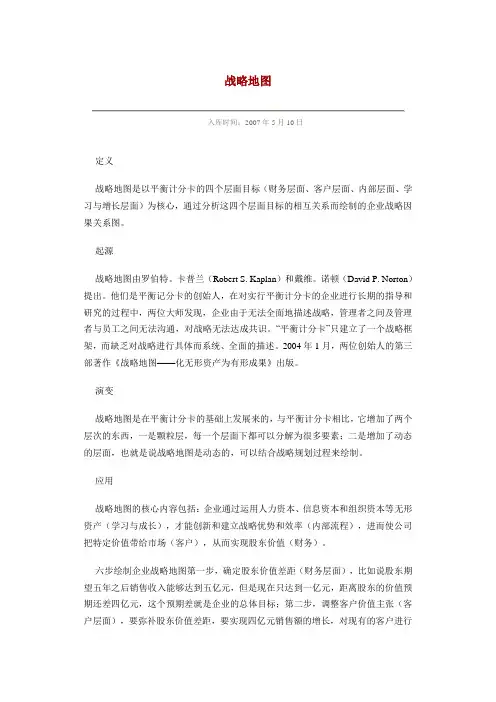
战略地图入库时间:2007年5月10日定义战略地图是以平衡计分卡的四个层面目标(财务层面、客户层面、内部层面、学习与增长层面)为核心,通过分析这四个层面目标的相互关系而绘制的企业战略因果关系图。
起源战略地图由罗伯特。
卡普兰(Robert S. Kaplan)和戴维。
诺顿(David P. Norton)提出。
他们是平衡记分卡的创始人,在对实行平衡计分卡的企业进行长期的指导和研究的过程中,两位大师发现,企业由于无法全面地描述战略,管理者之间及管理者与员工之间无法沟通,对战略无法达成共识。
“平衡计分卡”只建立了一个战略框架,而缺乏对战略进行具体而系统、全面的描述。
2004年1月,两位创始人的第三部著作《战略地图——化无形资产为有形成果》出版。
演变战略地图是在平衡计分卡的基础上发展来的,与平衡计分卡相比,它增加了两个层次的东西,一是颗粒层,每一个层面下都可以分解为很多要素;二是增加了动态的层面,也就是说战略地图是动态的,可以结合战略规划过程来绘制。
应用战略地图的核心内容包括:企业通过运用人力资本、信息资本和组织资本等无形资产(学习与成长),才能创新和建立战略优势和效率(内部流程),进而使公司把特定价值带给市场(客户),从而实现股东价值(财务)。
六步绘制企业战略地图第一步,确定股东价值差距(财务层面),比如说股东期望五年之后销售收入能够达到五亿元,但是现在只达到一亿元,距离股东的价值预期还差四亿元,这个预期差就是企业的总体目标;第二步,调整客户价值主张(客户层面),要弥补股东价值差距,要实现四亿元销售额的增长,对现有的客户进行分析,调整你的客户价值主张。
客户价值主张主要有四种:第一种是总成本最低,第二种价值主张强调产品创新和领导,第三种价值主张强调提供全面客户解决方案,第四种是系统锁定;第三步,确定价值提升时间表。
针对五年实现四亿元股东价值差距的目标,要确定时间表,第一年提升多少,第二年、第三年多少,将提升的时间表确定下来;第四步,确定战略主题(内部流程层面),要找关键的流程,确定企业短期、中期、长期做什么事。
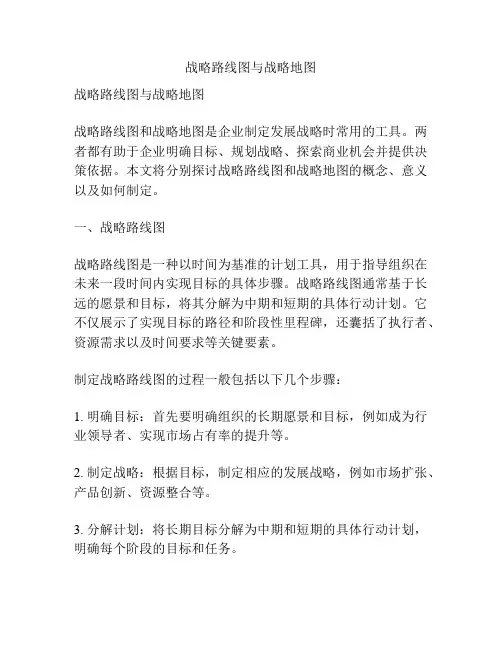
战略路线图与战略地图战略路线图与战略地图战略路线图和战略地图是企业制定发展战略时常用的工具。
两者都有助于企业明确目标、规划战略、探索商业机会并提供决策依据。
本文将分别探讨战略路线图和战略地图的概念、意义以及如何制定。
一、战略路线图战略路线图是一种以时间为基准的计划工具,用于指导组织在未来一段时间内实现目标的具体步骤。
战略路线图通常基于长远的愿景和目标,将其分解为中期和短期的具体行动计划。
它不仅展示了实现目标的路径和阶段性里程碑,还囊括了执行者、资源需求以及时间要求等关键要素。
制定战略路线图的过程一般包括以下几个步骤:1. 明确目标:首先要明确组织的长期愿景和目标,例如成为行业领导者、实现市场占有率的提升等。
2. 制定战略:根据目标,制定相应的发展战略,例如市场扩张、产品创新、资源整合等。
3. 分解计划:将长期目标分解为中期和短期的具体行动计划,明确每个阶段的目标和任务。
4. 确定关键要素:确定要执行的关键要素,例如需要的资源、人员需求、时间要求等。
5. 制定时间表:将每个阶段的行动计划安排到时间表中,明确完成每个阶段的时间节点。
6. 建立绩效指标:针对每个阶段的目标,建立相应的绩效指标,用于衡量实际执行情况和目标完成度。
一个好的战略路线图要具备可行性、灵活性和适应性。
它需要基于充分的市场调研、战略规划和资源评估来制定,并且应该能够根据外部环境变化和内部需求做出调整。
战略路线图的制定需要多方参与,包括高层管理者、市场部门、技术部门等,以确保制定的路线对组织整体发展有利。
二、战略地图战略地图是一种用图形方式展示战略规划的工具,用于展示市场目标、竞争优势和业务规划等信息。
战略地图通常分为不同的层次,既可以从整体上展示企业的战略规划,也可以从细分的市场或业务领域展示策略的具体实施。
制定战略地图的过程一般包括以下几个步骤:1. 定义核心竞争优势:明确企业的核心竞争力,例如技术优势、品牌优势、成本优势等。
2. 描绘市场格局:了解市场的现状和未来趋势,分析行业的结构、竞争态势和增长机会。
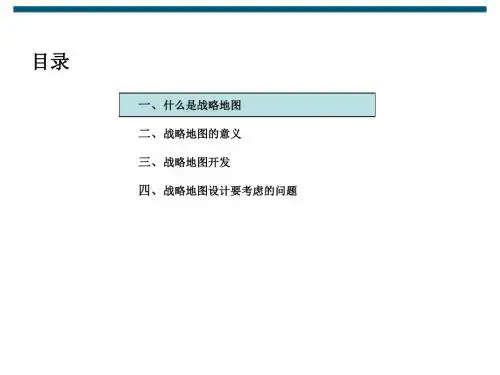
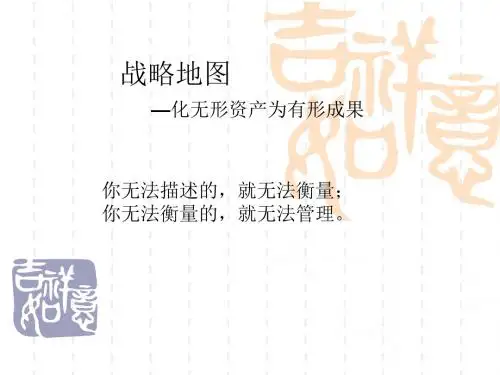

地图按用途分为战略地图地图按照用途的不同可以分为很多种类,其中战略地图是一种重要的地图类型。
战略地图是军事领域中用于战略决策和规划的一种地图,通过战略地图,决策者可以清晰地了解地形、地理条件以及资源分布情况,从而为决策和行动提供有效的参考和支持。
战略地图主要用于军事行动的规划和指导。
战争是一种动态的冲突活动,需要高度的战略调度和规划。
而战略地图则是军事指挥者进行计划和决策的重要工具。
战略地图通过准确地反映地理环境的情况,帮助指挥者了解自己和敌人所处的地理位置、地形、道路、桥梁等各种战略资源,并结合情报和军事情况进行分析和研判,为军事行动提供科学依据。
战略地图有辅助指挥、部署军队、决策战术、辨别地形和障碍物等多种功能。
首先,战略地图可以准确地标注出地理位置以及重要特征,例如山脉、河流、城市等,有利于指挥官进行整体规划和布署。
其次,战略地图可以划定作战边界、据点和资源,帮助军事指挥者决策作战路线和目标。
第三,战略地图可以辅助进行军队兵力的部署和调动,从而提高指挥效率。
第四,战略地图可以帮助指挥官分析地形和识别障碍物,为军事行动制定合理的战术和策略。
此外,战略地图还可以辅助进行情报分析和军事评估。
利用战略地图,可以更加全面地收集和整理军事情报,形成情报图谱,为指挥官提供战场情况的实时更新和情报的分析报告,从而为指挥决策提供科学依据。
战略地图还可以辅助进行军事评估,通过对地理环境的分析和评估,帮助指挥官评估战场和敌情的态势,制定相应的作战计划,提前做好应对战斗的准备。
总结来说,战略地图作为军事领域中的一种重要工具,具有多种功能和用途。
通过战略地图,指挥官可以清晰地了解地形、地理条件以及资源分布情况,为决策和行动提供有效的参考和支持。
在现代战争中,战略地图仍然是军事指挥者进行计划和决策的重要工具,对于保卫国家和实施军事行动具有重要的意义。

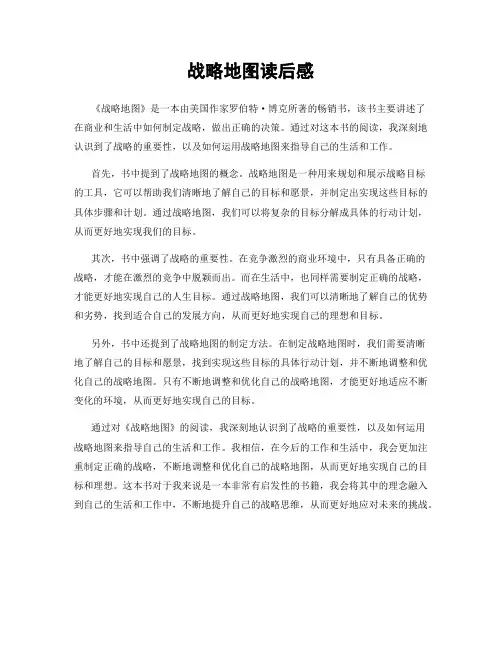
战略地图读后感
《战略地图》是一本由美国作家罗伯特·博克所著的畅销书,该书主要讲述了
在商业和生活中如何制定战略,做出正确的决策。
通过对这本书的阅读,我深刻地认识到了战略的重要性,以及如何运用战略地图来指导自己的生活和工作。
首先,书中提到了战略地图的概念。
战略地图是一种用来规划和展示战略目标
的工具,它可以帮助我们清晰地了解自己的目标和愿景,并制定出实现这些目标的具体步骤和计划。
通过战略地图,我们可以将复杂的目标分解成具体的行动计划,从而更好地实现我们的目标。
其次,书中强调了战略的重要性。
在竞争激烈的商业环境中,只有具备正确的
战略,才能在激烈的竞争中脱颖而出。
而在生活中,也同样需要制定正确的战略,才能更好地实现自己的人生目标。
通过战略地图,我们可以清晰地了解自己的优势和劣势,找到适合自己的发展方向,从而更好地实现自己的理想和目标。
另外,书中还提到了战略地图的制定方法。
在制定战略地图时,我们需要清晰
地了解自己的目标和愿景,找到实现这些目标的具体行动计划,并不断地调整和优化自己的战略地图。
只有不断地调整和优化自己的战略地图,才能更好地适应不断变化的环境,从而更好地实现自己的目标。
通过对《战略地图》的阅读,我深刻地认识到了战略的重要性,以及如何运用
战略地图来指导自己的生活和工作。
我相信,在今后的工作和生活中,我会更加注重制定正确的战略,不断地调整和优化自己的战略地图,从而更好地实现自己的目标和理想。
这本书对于我来说是一本非常有启发性的书籍,我会将其中的理念融入到自己的生活和工作中,不断地提升自己的战略思维,从而更好地应对未来的挑战。


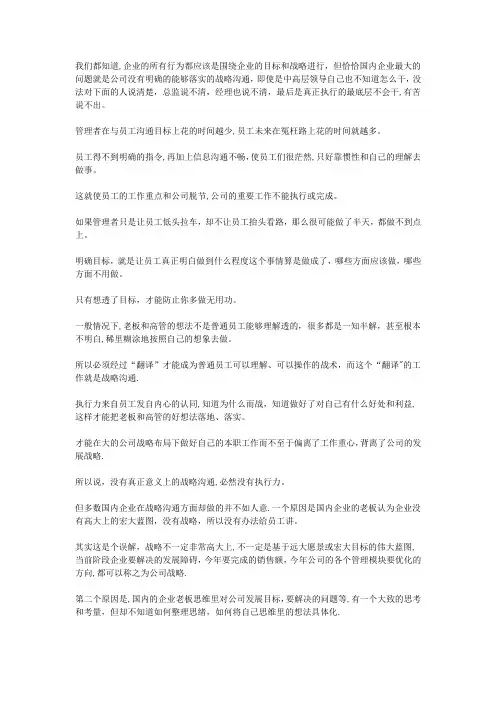
我们都知道,企业的所有行为都应该是围绕企业的目标和战略进行,但恰恰国内企业最大的问题就是公司没有明确的能够落实的战略沟通,即使是中高层领导自己也不知道怎么干,没法对下面的人说清楚,总监说不清,经理也说不清,最后是真正执行的最底层不会干,有苦说不出。
管理者在与员工沟通目标上花的时间越少,员工未来在冤枉路上花的时间就越多。
员工得不到明确的指令,再加上信息沟通不畅,使员工们很茫然,只好靠惯性和自己的理解去做事。
这就使员工的工作重点和公司脱节,公司的重要工作不能执行或完成。
如果管理者只是让员工低头拉车,却不让员工抬头看路,那么很可能做了半天,都做不到点上。
明确目标,就是让员工真正明白做到什么程度这个事情算是做成了,哪些方面应该做,哪些方面不用做。
只有想透了目标,才能防止你多做无用功。
一般情况下,老板和高管的想法不是普通员工能够理解透的,很多都是一知半解,甚至根本不明白,稀里糊涂地按照自己的想象去做。
所以必须经过“翻译”才能成为普通员工可以理解、可以操作的战术,而这个“翻译"的工作就是战略沟通.执行力来自员工发自内心的认同,知道为什么而战,知道做好了对自己有什么好处和利益,这样才能把老板和高管的好想法落地、落实。
才能在大的公司战略布局下做好自己的本职工作而不至于偏离了工作重心,背离了公司的发展战略.所以说,没有真正意义上的战略沟通,必然没有执行力。
但多数国内企业在战略沟通方面却做的并不如人意.一个原因是国内企业的老板认为企业没有高大上的宏大蓝图,没有战略,所以没有办法给员工讲。
其实这是个误解,战略不一定非常高大上,不一定是基于远大愿景或宏大目标的伟大蓝图,当前阶段企业要解决的发展障碍,今年要完成的销售额,今年公司的各个管理模块要优化的方向,都可以称之为公司战略.第二个原因是,国内的企业老板思维里对公司发展目标,要解决的问题等,有一个大致的思考和考量,但却不知道如何整理思绪,如何将自己思维里的想法具体化.自己都没有梳理好,自然就不知道怎么沟通。
战略地图(重定向自战略图表)战略地图(Strategy Map)——战略制定工具目录[隐藏]∙ 1 什么是战略地图∙ 2 战略地图的核心内容o 2.1 六步绘制企业战略地图∙ 3 判断战略地图有效性的两个基本要素o 3.1 KPI的数量及分布比例o 3.2 KPI的性质比例∙ 4 战略地图与价值链比较∙ 5 战略地图案例分析o 5.1 案例一:湖北移动公司运用战略地图o 5.2 案例二:利兹大学的战略地图[1]∙ 6 参考文献[编辑]什么是战略地图战略地图由罗伯特·卡普兰(Robert S. Kaplan)和戴维·诺顿(David P. Norton)提出。
他们是平衡记分卡的创始人,在对实行平衡计分卡的企业进行长期的指导和研究的过程中,两位大师发现,企业由于无法全面地描述战略,管理者之间及管理者与员工之间无法沟通,对战略无法达成共识。
“平衡计分卡”只建立了一个战略框架,而缺乏对战略进行具体而系统、全面的描述。
2004年1 月,两位创始人的第三部著作《战略地图——化无形资产为有形成果》出版。
战略地图是在平衡计分卡的基础上发展来的,与平衡计分卡相比,它增加了两个层次的东西,一是颗粒层,每一个层面下都可以分解为很多要素;二是增加了动态的层面,也就是说战略地图是动态的,可以结合战略规划过程来绘制。
战略地图是以平衡计分卡的四个层面目标(财务层面、客户层面、内部层面、学习与增长层面)为核心,通过分析这四个层面目标的相互关系而绘制的企业战略因果关系图。
[编辑]战略地图的核心内容战略地图的核心内容包括:企业通过运用人力资本、信息资本和组织资本等无形资产(学习与成长),才能创新和建立战略优势和效率(内部流程),进而使公司把特定价值带给市场(客户),从而实现股东价值(财务)。
[编辑]六步绘制企业战略地图第一步,确定股东价值差距(财务层面),比如说股东期望五年之后销售收入能够达到五亿元,但是现在只达到一亿元,距离股东的价值预期还差四亿元,这个预期差就是企业的总体目标;第二步,调整客户价值主张(客户层面),要弥补股东价值差距,要实现四亿元销售额的增长,对现有的客户进行分析,调整你的客户价值主张。
如何理解与正确运用战略地图-01战略地图是企业非常重要的战略工具,平衡计分卡是企业非常重要的绩效评价工具,一般来说战略地图是平衡计分卡的先导,也是很好理解与运用平衡计分卡的基础,战略地图具有整体性,系统性和时间序列性,它对企业的平衡计分卡具有重要的指导意义。
平衡计分卡是重要的绩效评价体系,它与战略地图的相互结合使用,可谓双剑合壁,天下无敌了。
下面我们主要谈一谈如何理解与正确运用战略地图,战略地图如何与平衡计分卡结合起来使用的。
1、战略地图的概念战略地图是在平衡计分卡的基础上发展来的,与平衡计分卡相比,它增加了两个层次的东西,一是颗粒层,每一个层面下都可以分解为很多要素;二是增加了动态的层面,也就是说战略地图是动态的,可以结合战略规划过程来绘制。
2、战略地图的与平衡计分卡的关系战略地图是以平衡计分卡的四个层面目标(财务层面、客户层面、内部层面、学习与增长层面)为核心,通过分析这四个层面目标的相互关系而绘制的企业战略因果关系图。
3、战略地图的简介战略地图的核心内容包括:企业通过运用人力资本、信息资本和组织资本等无形资产(学习与成长),才能创新和建立战略优势和效率(内部流程),进而使公司把特定价值带给市场(客户),从而实现股东价值(财务)。
4、六步绘制企业战略地图第一步,确定股东价值差距(财务层面),比如说股东期望五年之后销售收入能够达到五亿元,但是公司只达到一亿元,距离股东的价值预期还差四亿元,这个预期差就是企业的总体目标;第二步,调整客户价值主张(客户层面),要弥补股东价值差距,要实现四亿元销售额的增长,对现有的客户进行分析,调整你的客户价值主张。
客户价值主张主要有四种:第一种是总成本最低,第二种价值主张强调产品创新和领导,第三种价值主张强调提供全面客户解决方案,第四种是系统锁定;第三步,确定价值提升时间表。
针对五年实现四亿元股东价值差距的目标,要确定时间表,第一年提升多少,第二年、第三年多少,将提升的时间表确定下来;第四步,确定战略主题(内部流程层面),要找关键的流程,确定企业短期、中期、长期做什么事。
企业战略地图绘制培训资料xx年xx月xx日•战略地图概述•战略地图的基本要素•战略地图的绘制步骤目录•战略地图的应用•战略地图的注意事项01战略地图概述战略地图是一种可视化的战略规划工具,将企业战略目标与财务、客户、内部业务流程、学习与成长等维度进行关联和映射,帮助企业清晰地了解战略目标及其相互之间的关系。
战略地图通过图表和指标展示企业战略目标的层次结构和关键要素,旨在使企业能够更好地实现长期战略目标。
战略地图的定义战略地图的起源与发展战略地图的起源可以追溯到20世纪90年代,当时美国管理学家罗伯特·卡普兰和戴维·诺顿提出了平衡计分卡的概念。
1996年,两位学者在《哈佛商业评论》上发表了平衡计分卡方面的第一篇论文,随后将平衡计分卡方法应用于企业战略规划和管理中,帮助企业建立战略地图。
随着时间的推移,战略地图逐渐成为企业战略规划和管理的重要工具,并在全球范围内得到广泛应用。
战略地图可以帮助企业明确战略目标,将企业战略目标与各个层次的目标进行衔接,从而确保企业战略的有效实施。
战略地图可以帮助企业进行绩效评估和管理,将战略目标与绩效指标进行关联,从而为企业提供有效的绩效评估工具。
战略地图还可以帮助企业进行战略调整和优化,根据实际情况及时调整战略目标和行动计划,使企业更加适应市场变化和竞争环境。
战略地图可以促进企业内部沟通和协调,使各部门和员工更好地理解企业战略目标和行动计划,提高企业内部合作与凝聚力。
战略地图的重要性02战略地图的基本要素目标与目的明确企业的使命、愿景和价值观,为企业发展提供导向。
根据市场需求、竞争态势等因素,制定企业中、长期发展目标。
确定各业务领域的战略目标和关键成果,为组织提供明确的发展方向。
客户与市场了解目标客户群体的需求、偏好和行为特征,为市场定位提供依据。
对市场进行细分,确定企业在目标市场中的竞争地位。
制定针对不同市场的营销策略,提升品牌知名度和客户满意度。